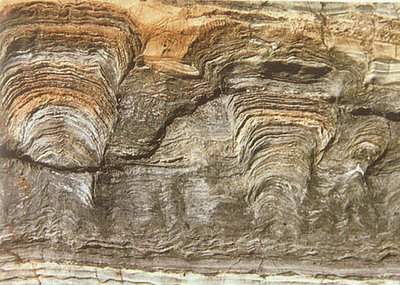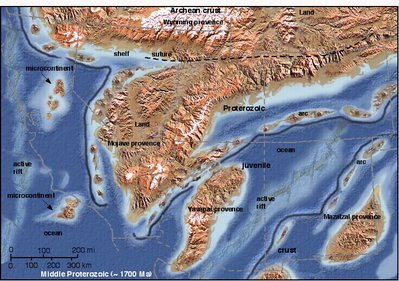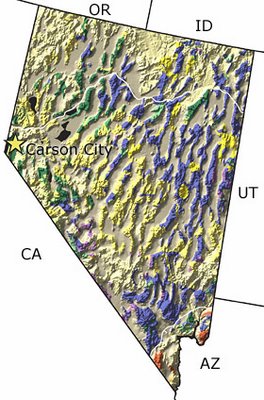
Fossil Stromatolites
Middle Proterozoic - 1700 MA (You can just make out the grey dotted lines of the present state lines. Look for Arizona, California, Nevada.)

"The interpretation of the earliest geologic history of Southwestern North America is very speculative. At approximately 1.7 Ga (1700 Ma), the region probably resembled modern SE Asia. As various tectonic blocks collided, orogenic (mountain-building) events were generated. This view shows what the region may have looked like during these collisional events."
Mesoproterozoic - 1100 MA

"About 1.1 Ga North America was part of the supercontinent Rodinia. The Southwest possibly lay adjacent to Australia and/or Antarctica or possibly Siberia. An arc complex lay off southern North America. Various sedimentary rocks were formed near the margins of North America."
Neoproterozoic - 650 MA

"The western margin of North America (NAM) was originally formed during the late Proterozoic (Precambrian), about 650 million years ago, during a major rifting event in which North America separated from the supercontinent Rodinia. The map shows the hypothetical pattern of rifting and the resulting patterns of late Proterozoic siliciclastic sedimentation. The rifted, attenuated (thinned and stretched) margin subsided and was the site of thick sequences of sandstone, mudstone, and limestone. The Cordilleran passive margin was born."
Arizona - Geologic Periods in Arizona (See the interstates.) There are a lot of resources for Arizona at The Paleontology Portal. See the link under Resources on the sidebar.

Locations of Exposed Precambrian Deposits in Arizona

Precambrian rocks in Arizona record at least three sequences of deposition, metamorphism, and erosion. Sediments were deposited, buried, turned to rock, and altered by heat and pressure. Then some of the rocks were eroded, and new sediments were laid down. By the Late Precambrian, shallow marine conditions prevailed throughout the state. The limestones formed from this time contain fossil evidence of stromatolites.
California


Precambrian rocks in California include igneous and metamorphic basement rocks, as well as some sedimentary rocks (limestone, dolostone, and sandstones, which have often been altered to quartzite). These sedimentary rocks can be found in the White Mountains, Inyo Mountains, and around Death Valley. Most of these rocks do not contain fossils, although some traces and a few fossils have been found in the younger geologic formations of Precambrian age.
Geologic Map of California
Fossils from the Precambrian in California.
Algae

Platysolenites, Shells of Foraminifer

Stromatolites

Worm holes (?)

Fossils In Death Valley National Park
Nevada


Little is known of the Early Precambrian history of Nevada, as few rocks of this age are preserved. In the Late Precambrian, shallow seas began to flood onto the edge of a quiet continental margin, one where no tectonic activity was occurring. The land was a flat plain with no mountains, and rivers deposited quartz-rich sandstones at the river mouths and nearshore areas. In slightly deeper water, silts and clays were deposited on muddy bottoms. The rocks formed from these sediments can be seen today in the southern and eastern parts of the state. Some very unusual fossils---shelly tubes a few millimeters in length---have been described from Precambrian rocks in Esmeralda County in western Nevada.
See Guide to Fossils in Death Valley National Park above.






No comments:
Post a Comment